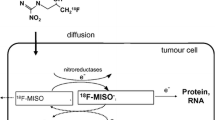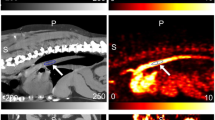Abstract.
Tumor hypoxia is an important prognostic indicator for cancer therapy outcome. EF5 {2-(2-nitro-1[H]-imidazol-1-yl)-N-(2,2,3,3,3-pentafluoropropyl)-acetamide} has been employed to measure tumor hypoxia in animals and humans using immunohistochemical methods. EF5 is a lipophilic molecule designed to have a very uniform biodistribution, a feature of obvious benefit for use in PET imaging. The present study represents the first demonstration of noninvasive PET imaging of rat tumors using fluorine-18 labeled EF5. Because of the small tumor size, partial volume effects may result in underestimation of concentration of the compound. Therefore, validation of the PET data was performed by gamma counting of the imaged tissue. The tumor models studied were the Morris 7777 (Q7) hepatoma (n=5) and the 9L glioma (n=2) grown subcutaneously in rats. Our previous studies have demonstrated that early passage 9L tumors are not severely hypoxic and that Q7 tumors are characterized by heterogeneous regions of tumor hypoxia (i.e., Q7 tumors are usually more hypoxic than early passage 9L tumors). The seven rats were imaged in the HEAD Penn-PET scanner at various time points after administration of 50–100 µCi 18F-EF5 in 30 mg/kg carrier nonradioactive EF5. The carrier was used to ensure drug biodistribution comparable to prior studies using immunohistochemical methods. 18F-EF5 was excreted primarily via the urinary system. Images obtained 10 min following drug administration demonstrated that the EF5 distributed evenly to all organ systems, including brain. Later images showed increased uptake in most Q7 tumors compared with muscle. Liver uptake remained relatively constant over the same time periods. Tumor to muscle ratios ranged from 0.82 to 1.73 (based on PET images at 120 min post injection) and 1.47 to 2.95 (based on gamma counts at ~180 min post injection). Tumors were easily visible by 60 min post injection when the final tumor to muscle ratios (based on gamma counts) were greater than 2. Neither of the 9L tumors nor the smallest Q7 tumor met this criterion, and these tumors were not seen on the PET images. These preliminary results suggest that 18F-EF5 is a promising agent for noninvasive assessment of tumor hypoxia. Plans are underway to initiate a research project to determine the safety and preliminary evidence for the efficacy of this preparation in patients with brain tumors.
Similar content being viewed by others
Author information
Authors and Affiliations
Additional information
Electronic Publication
Rights and permissions
About this article
Cite this article
Ziemer, .L., Evans, .S., Kachur, .A. et al. Noninvasive imaging of tumor hypoxia in rats using the 2-nitroimidazole 18F-EF5. Eur J Nucl Med 30, 259–266 (2003). https://doi.org/10.1007/s00259-002-1037-5
Received:
Accepted:
Issue Date:
DOI: https://doi.org/10.1007/s00259-002-1037-5




